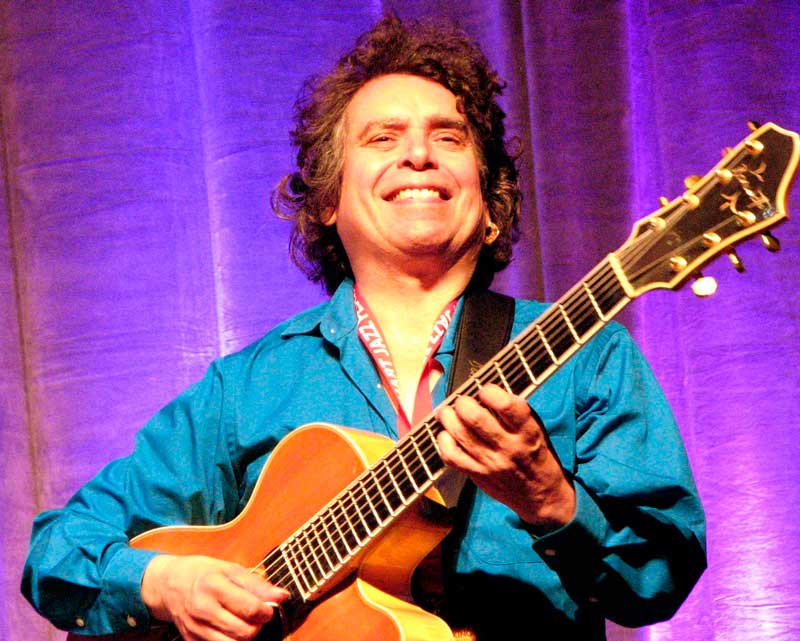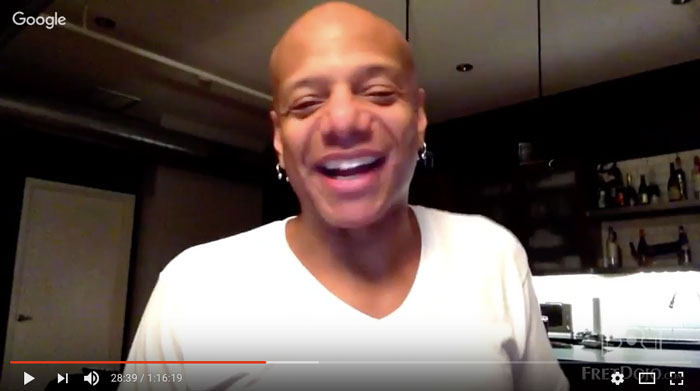
This week on FretDojo, I’m happy to share with you an interview I recently held with internationally acclaimed jazz guitarist Howard Alden.
Podcast: Play in new window | Download (Duration: 1:09:08 — 47.5MB)
Get Notified Of Future Episodes Apple Podcasts | TuneIn | RSS | More
Howard is one of the leaders of jazz guitar in the modern era. His accolades include:
- Student the Guitar Institute of Technology in 1977-78 with Herb Ellis, Joe Pass, and Howard Roberts
- Collaborations with Dick Hyman, Dan Barrett, Bucky Pizzarelli and many others
- Alden recorded the guitar performances for Sean Penn‘s character Emmet Ray in Woody Allen‘s 1999 film Sweet and Lowdown – and taught Penn how to mime the performances for the film(!)
- Recorded many albums with Concord Records as well as other labels, including four with the famed 7 string jazz guitar innovator George Van Eps
- Has been the recipient of many awards, including:
- Best Emerging Guitar Talent, JazzTimes (1990)
- Guitar Player of the Year, American Guitar Museum (2003)
- Top 75 Guitarists, Down Beat (2008)
- Jazz critics have said of Howard Alden that “He may be the best of his generation” and “the most impressive and creative member of a new generation of jazz guitarists.”
In the interview below, I go on a deep dive with Howard about his journey with jazz guitar from a youngster to where he is today. I also ask Howard to reveal his secrets for how to maximise the results you get in the practice room – there were some fantastic tips Howard gives in this interview that you should definitely pay attention to.
Resources mentioned by Howard Alden:
- 3 Part Guitar Compendium by the late Howard Roberts and Garry Hasberg (3 book set)
- George Van Eps Guitar Solos (book)
- Solos From “Sweet and Lowdown” – Howard Alden (book)
- Featured during the interview are tracks from Howard Alden’s recently released solo jazz guitar album ‘Guitar’ – get your copy here.
Find out more about Howard at howardalden.com


Great interview. I’ll get that album. As a student who took your fundamentals course, I can say he hit on all the important practice points that you have taught: guide tones; learn many tunes and the melodies; learn vocabulary as opposed to scales even though scales are a foundational necessity but don’t get stuck there; necessity of community or actually playing with someone (backing tracks still are a good start; find a teacher. One point that you haven’t mentioned is playing the melody with the base notes (I imagine it to be more that the root of the cord and more of a line). One point I especially liked was picking less well known tunes to work on (within one’s capability of course). Thinking some of the Charlie Parker tunes that even if well known, the cooking head is a bebop lesson in itself. Thanks much.
Hey ! Good stuff Greg.,
Also, I found these very useful too.
I just love the lines of horn players in the 60’s ( CD blue note series ) and I often wondered how did they do it ? — is it possible to adapt to guitar ?
Well you can and it helps to learn their phrasing and their story vocabulary
Jerry Coker’s 2 classics: complete method of improvisation and patterns for jazz are very useful indeed
and if you follow John Stowell’s advice about running the melodic minor aperggio, o broken scale fragments over dominants and ( altered ones too ) you begin to make satisfying progress — of course you can adopt Stowell’s tip of playing the melodic minor a semitone above ; below; a fourth of fifth and then add in for spice some scale tones with your own rhythm and syncopation — you will create something new.
Only problem you have to pre-plan all this before you can internalize it and play on the spot — bands will be impressed by your knowledge !
it will get you more gigs and out of practice room in the garage.
Howard Alden seems to be of my age. I think I once mentioned here already that I grew up in a very remote part of Germany in the early 50s but with a lot of swing music in my early childhood ( American forces network) and R&R/B in the 60s.
Absolutely no guitar teacher in these styles within 100 miles! Being the absolute autodidact I found a funny guitar LP in the local shop. It happened to be a Howard Roberts’ LP… ( a US soldier had ordered it and forgotten). Strange music for me as a Beatles and Stones fan , but I was so fascinated that I gradually ordered the rest of the 13 Capitol LPs by HR. Having no idea of 2-5-1 or altered chords at that time I could only understand and learn Roberts’ bluesy titles and improvisations BY EAR.
And here comes my new point:
“the compendium of 3 books”
At the age of 30 I finally met Mr Roberts here in Germany at a workshop organized by J.Aebersold and had 1 week of lessons.
So I once asked him to play a solo “transcription” in one of those 3 books published under his name that I had not found on my LPs at home. Roberts tried 3times and got stuck every time after a few bars!
“Who has written this? ” And he looked at the cover. ( You?!) ” I don’t know what this guy (Gary) wrote down here…What does he want…?”
So my dear guitar fellowmen , don’t get too frustrated, if you try to play the solo pieces written by Howard Roberts ‘ “ghostwriter”. You are not the only ones to fail, haha
Great interview Greg…You asked all the right questions…not only are you an accomplished jazz guitar teacher, but also a fine journalist! There is a lifetime of practice outlined by Howard in this interview.